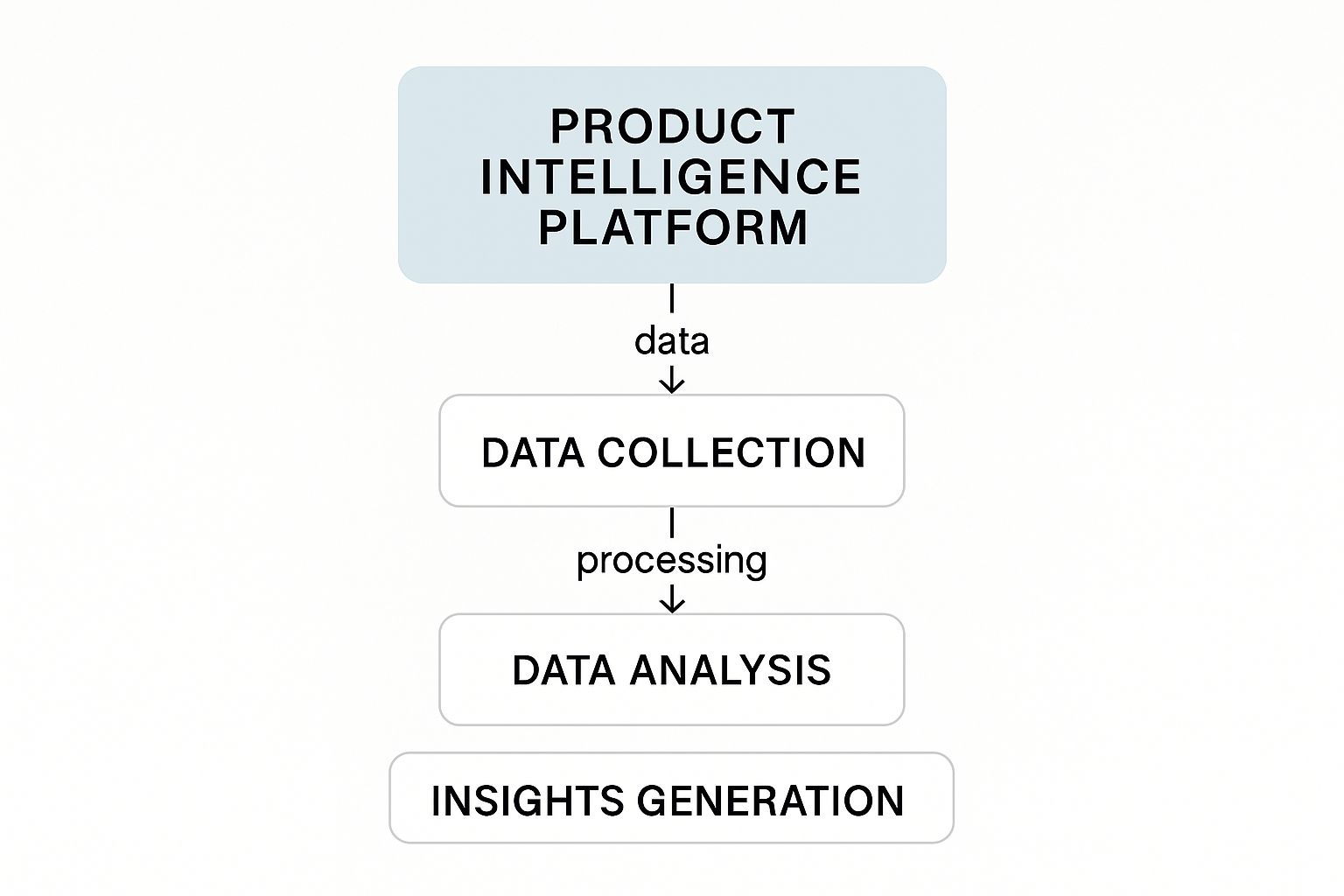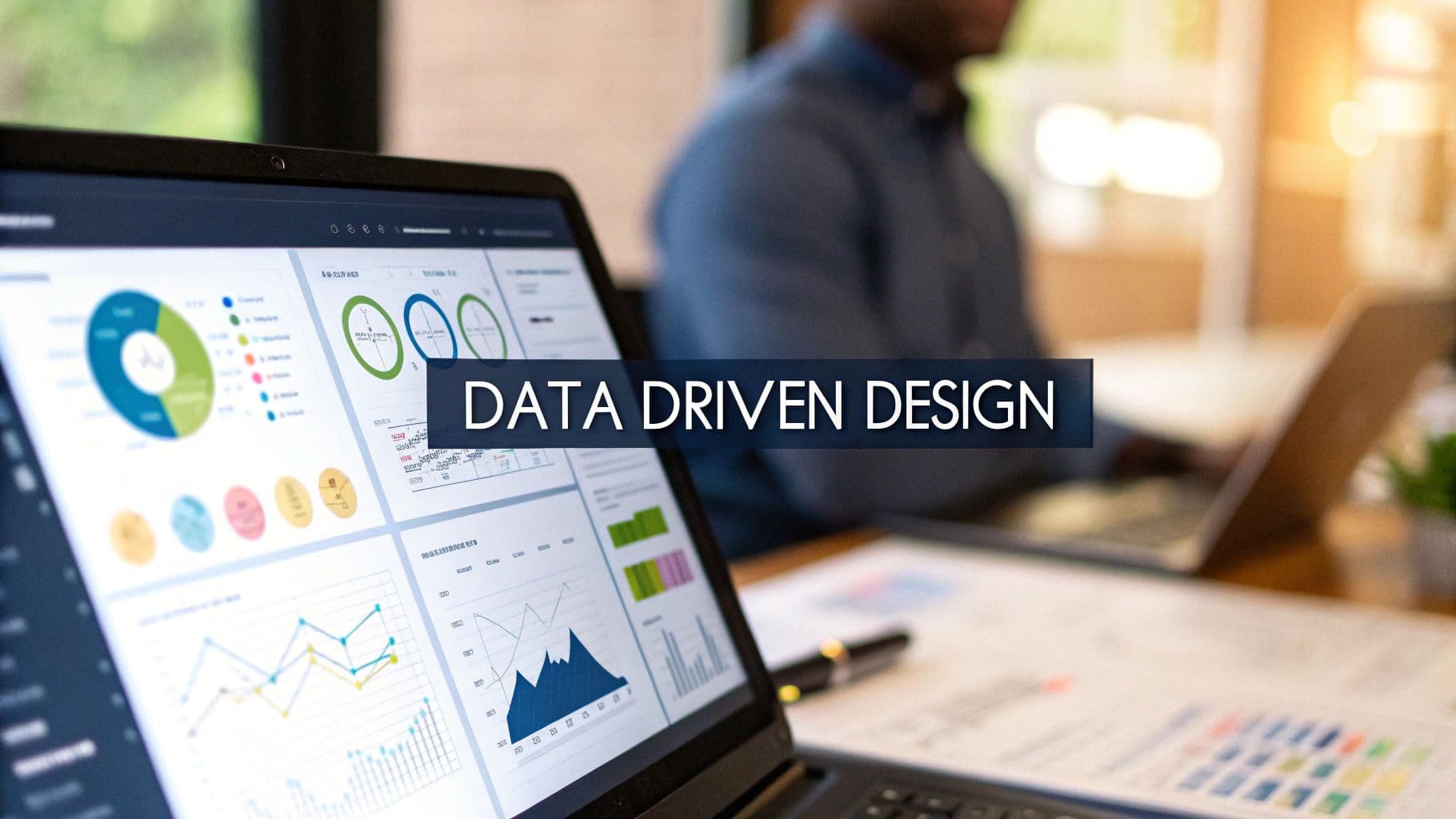Your Guide to a Product Intelligence Platform
Discover how a product intelligence platform drives growth. This guide covers key features, benefits, and how to choose the right tools for your business.

A product intelligence platform isn't just another analytics tool. Think of it as a specialized system designed to gather, analyze, and show you exactly how people use your digital product, giving you real, actionable insights. It goes way beyond traditional analytics by connecting what users do with the why behind their actions. This allows your team to stop guessing and start making data-informed decisions that genuinely improve the user experience and, ultimately, your bottom line.
What Is a Product Intelligence Platform
Imagine you're trying to find your way through a huge, unfamiliar city. If you only have a compass, you know which way is north, but you have no clue about one-way streets, traffic jams, or construction detours. That's what old-school product analytics feels like. It gives you basic numbers—like daily active users or page views—but misses all the crucial context you need to understand the actual user journey.
A product intelligence platform is your product’s GPS. It doesn't just point you in a direction; it gives you a live, detailed map of the entire landscape. This kind of platform pulls together all sorts of complex data, from in-app clicks and feature usage rates to customer feedback buried in support tickets and surveys, painting a complete picture.
From Data Points to Actionable Insights
The real magic of a product intelligence platform is its ability to turn a mountain of raw data into a clear story about your users. Instead of just knowing that 30% of users drop off during checkout, you can see the exact step where they get stuck. You can identify which user groups are struggling the most and even watch session replays to see their frustration firsthand.
This clarity empowers teams in several key ways:
- Understand User Behavior: See every click, scroll, and interaction to learn which features people love and which ones they ignore.
- Optimize the Customer Journey: Find and fix the friction points in critical flows, like onboarding or making a purchase.
- Increase Retention: Get ahead of problems that cause churn and solve them before more users are affected.
- Prioritize Development: Use hard data to decide which new features or bug fixes will have the biggest impact.
This concept map breaks down the flow, showing how raw data is collected, organized, and finally transformed into strategic insights that drive decisions.

As the visual shows, the platform’s value isn't just about collecting data. It’s about the structured process of turning that data into meaningful intelligence you can actually act on.
The Growing Importance of Product Intelligence
This shift from surface-level metrics to deeper, more integrated analytics is clear in the market's direction. The global market for AI platforms, which includes product intelligence tools, is growing at an incredible pace. Recently valued at around USD 54.9 billion, it's projected to skyrocket to an estimated USD 1,227.19 billion by 2033—that's a compound annual growth rate of roughly 39.5%. You can read the full research about AI platform market growth for a deeper dive.
The table below highlights just how big of a leap this is from what we're used to.
Traditional Analytics vs Product Intelligence
| Capability | Traditional Product Analytics | Product Intelligence Platform |
|---|---|---|
| Focus | Measures what happened (e.g., page views, clicks). | Explains why it happened by connecting user actions. |
| Data Scope | Often siloed, focusing on web or mobile metrics. | Holistic view, combining user behavior, feedback, and more. |
| Primary Use | Reporting high-level trends and KPIs. | Driving product strategy and improving user experience. |
| Insights | Quantitative data points (e.g., "70% of users clicked"). | Qualitative and quantitative insights (e.g., "Users are confused by this button, causing drop-offs"). |
| User View | Aggregated and anonymous user counts. | Individual user journey mapping and session replays. |
In short, while traditional analytics gives you a scorecard, product intelligence gives you the full game tape, complete with commentary.
At the end of the day, these platforms provide the hard evidence needed to build truly customer-centric products. They make sure every decision is grounded in a real understanding of the user experience, not just a hunch or a guess.
Looking Under the Hood: The Core Capabilities of Product Intelligence

To really get what a product intelligence platform does, you have to look past the slick dashboards. Deep down, these platforms are powered by a few specific, heavy-hitting capabilities that work in concert to turn a flood of raw data into a clear story about your users.
These aren't just items on a feature checklist; they’re the analytical engines that fuel smart, strategic product decisions.
Think of it like a master mechanic’s diagnostic tools. They don't just guess what's wrong with an engine; they plug in specific instruments to read performance data, listen for subtle variations, and pinpoint the exact source of an issue. A product intelligence platform gives you a similar set of tools to diagnose user behavior from every conceivable angle.
Advanced User Segmentation
The starting point for any meaningful analysis is advanced user segmentation. Old-school analytics might let you group users by basic demographics like age or location, but that’s not what drives a product forward. A product intelligence platform segments users based on what they actually do inside your app. This behavioral approach is infinitely more valuable.
For example, you can instantly create and track groups like:
- Power Users: People who used a core feature more than 10 times in the last week.
- Stuck Onboarding: New sign-ups from the last 72 hours who haven't finished the initial setup.
- Potential Churn: Previously active customers who haven't logged in for 30 days.
This is where the magic happens. By isolating these groups, you can compare how they navigate your product, revealing patterns that would otherwise be completely invisible. You can finally see which features your best customers love or exactly where new users are getting frustrated and giving up.
Funnel Analysis for Mapping User Journeys
Once you've defined your user groups, you need to understand their journeys. This is the job of funnel analysis. A funnel is just a series of steps you hope a user will take to reach a goal, whether that's completing a purchase, inviting a teammate, or upgrading their plan.
Funnel analysis shows you, step-by-step, how many people make it through the entire process. It’s a brutally honest way to see where your user experience is breaking down. Imagine your e-commerce checkout has five steps. A funnel report might reveal that while 90% of users add an item to their cart, only 40% actually finish the purchase.
But it gets better. The report would pinpoint the exact step—maybe the clunky shipping information page—where you lose the most people. This kind of insight is pure gold for product teams. It stops the guesswork and tells them precisely where to focus their energy to boost conversions.
Cohort Analysis for Understanding Retention
While funnels are perfect for mapping specific, short-term journeys, cohort analysis is your go-to for understanding long-term behavior and retention. A cohort is simply a group of users who share a common trait, most often their sign-up date. For instance, everyone who joined your product in the first week of March belongs to the "March Week 1" cohort.
By tracking these groups over weeks and months, you can see how their engagement changes over time. This helps you answer the most critical business questions:
- Are users who signed up after our big June feature launch sticking around longer than the May cohort?
- How does the 30-day retention for our mobile users compare to desktop users?
- Did that new onboarding flow we rolled out actually improve user activity in the first week?
For a streaming service, cohort analysis could show that users who watch a sci-fi show within their first three days are 50% more likely to still be subscribers three months later. This is the kind of deep, time-based insight that’s essential for building a product that doesn’t just attract users, but keeps them coming back for more.
How Product Intelligence Actually Drives Business Growth
Knowing what a product intelligence platform can do is one thing. But seeing how those capabilities translate into real-world business success? That's where things get interesting. These platforms aren't just fancy data dashboards; they are engines for growth, plain and simple. They connect the dots between what users do and the outcomes that matter to your bottom line, helping you make smarter, more profitable decisions.
When you shift from guesswork to a data-backed strategy, you start seeing measurable improvements almost immediately. We're talking about better user retention, higher conversion rates, and a faster innovation cycle. The insights you get aren't just abstract numbers—they're a clear roadmap for building a stickier, more valuable product.
Boosting User Retention
For any subscription business, high user retention is the foundation of long-term success. A product intelligence platform is your best friend here. It helps you spot the subtle warning signs of user frustration long before someone decides to cancel. By digging into behavioral patterns, you can pinpoint confusing features or broken workflows that are quietly pushing people away.
Think about an analytics company that sees a dip in engagement. They look at their product intelligence data and notice users are bailing when they try to build custom dashboards. A little more digging reveals the process is clunky and overly complicated. Fixing that one friction point can completely change the user experience, preventing those customers from even thinking about looking for an alternative.
Improving Conversion Rates
From the moment someone signs up to the second they pull out their credit card, every step in the user journey is a chance to win or lose them. Funnel analysis, a core feature in any product intelligence tool, is built to optimize these make-or-break moments. It gives you a crystal-clear, visual map of where users are dropping off, showing you exactly where you're leaking potential revenue.
This dashboard from Amplitude is a perfect example of how these platforms visualize the user journey, making it incredibly easy to see where your conversion funnel is breaking down.

You can see the step-by-step conversion flow, which highlights not just how many users make it through each stage, but more importantly, where they get stuck.
Accelerating Product Innovation
Great ideas are born from quick feedback loops. A product intelligence platform radically shortens the time between launching a feature and understanding its real impact. Forget waiting weeks for survey responses—you can see, in real-time, how people are actually using your new release.
This immediate feedback is gold. It lets you iterate at a speed you couldn't before. Did the new feature boost engagement like you hoped? Are people finding it? Are they using it in weird, unexpected ways? Getting answers to these questions fast means you can pour resources into what’s working and quickly kill what isn’t, saving a ton of time and money.
Here’s a real-world scenario:
- The Problem: A SaaS company had a 14-day free trial, but very few users were converting to a paid plan. They were stumped.
- The Insight: Using their platform, they discovered a massive 75% drop-off right at the onboarding step that asked users to integrate their calendar. For a first-time user, it felt like too big of a commitment.
- The Fix: They made the calendar integration optional and added a simple tutorial video to guide users instead.
- The Result: That one small change worked wonders. Their trial-to-paid conversion rate jumped by 15% in a single month, adding directly to their revenue.
This is what it's all about—turning data points into tangible business growth.
Turning User Data Into Customer Understanding

A great product doesn't just work; it clicks with people on a deeper level. To get there, you have to understand the human beings behind all the taps and mouse movements. This is where a product intelligence platform really shines—it helps you turn a mountain of raw user data into genuine customer understanding.
It’s all about bringing together two very different, yet equally powerful, types of information. On one hand, you have the hard numbers from behavioral data, which show you what users are doing. On the other, you have qualitative feedback from surveys, support tickets, and reviews, which tells you why they're doing it.
When you blend these two streams, you finally get a complete picture of the customer experience. You stop seeing anonymous data points and start seeing people with real goals, frustrations, and motivations.
Building Rich User Personas
Let's be honest, traditional user personas are often built on educated guesses and demographic clichés. A product intelligence platform completely changes the game by grounding your personas in cold, hard, observable behavior. You can finally move past vague descriptions like "small business owner" and create profiles backed by real data.
For instance, you might uncover a persona you call "The Cautious Optimizer." This isn't just a guess; the data shows this user:
- Logs in weekly to check performance metrics.
- Avoids new features for at least a month after they launch.
- Frequently contacts support for clarification before making any changes.
This level of detail, pulled from both analytics and actual support tickets, gives your team everything they need to design features and write documentation that speaks directly to this user's needs.
This fusion of data isn't a niche idea; it's a massive market trend. The customer intelligence platform market, a core component of this ecosystem, was recently valued at USD 3.09 billion. It’s expected to explode to USD 13.81 billion by 2030, growing at a compound annual rate of about 29.2%. You can discover more insights about the customer intelligence market to see just how big this is becoming.
Mapping Empathetic Customer Journeys
Knowing your personas is the first step. Mapping their journeys is what comes next. With all your data in one place, you can trace a user's path from their very first interaction to the moment they become a loyal fan—or the moment they churn. This isn't just a technical flowchart; it's an empathy map that reveals the emotional highs and lows.
You might see that a user flew through your onboarding process (a high point) but consistently gets stuck trying to use a specific reporting feature (a major point of friction). This insight shows you exactly where the experience is breaking down and why. By connecting a drop-off in your product funnel to a spike in frustrated support tickets about that exact feature, you have undeniable proof of what you need to fix.
Personalizing Experiences at Scale
At the end of the day, this deep understanding allows you to personalize the user experience in ways that actually matter. Forget generic marketing blasts. You can now deliver targeted in-app guidance, proactive support, or relevant feature announcements based on what a specific user has actually done and said.
This is how you build products that create true loyalty. When users feel like you "get" them, they don't just use your product—they become invested in its success.
Picking the Right Product Intelligence Platform
Choosing a product intelligence platform is a big deal. It’s a decision that can genuinely steer the direction of your company’s growth. The market is packed with vendors, and every sales pitch sounds amazing, making it easy to get sidetracked by flashy features. To find a true partner for long-term success, you need a clear, methodical approach that cuts through the noise and focuses squarely on what your business actually needs.
Think of this as more than just a software purchase. You're investing in a whole new way of listening to your customers and understanding their behavior. The right platform puts solid data in the hands of everyone from product managers to marketers, giving them the confidence to make smart calls. The wrong one? It just becomes a sinkhole for time and money, with low adoption and a lot of missed opportunities.
Can It Grow With You? Check for Scalability and Performance
Your company isn't static, and your tools shouldn't be either. The product intelligence platform you choose has to be able to keep up as you grow. A tool that hums along happily with a thousand users might just fall over and die when you hit one million. You have to look under the hood and see if the platform can handle a massive influx of data without slowing to a crawl.
When you're talking to vendors, get specific. Don't be shy about asking the tough questions about their architecture:
- Data Spikes: What happens when user activity suddenly goes through the roof? Can the platform ingest all that data without a hiccup?
- Query Speed: Sure, that report runs in two seconds today. But what happens when our user base is ten times larger? Will we be waiting minutes—or hours?
- Team Access: Is there a limit on how many people can be logged in and working at the same time?
Ignoring scalability is a classic mistake. It feels fine at first, but it almost always leads to a painful and expensive migration a couple of years down the line.
How Well Does It Play With Others? Assess Integration Capabilities
A product intelligence platform shouldn't be a data island. It truly becomes powerful when it’s connected to the other tools your teams use every single day. Before you even think about signing a contract, map out your current tech stack and make sure the platform offers solid, native integrations.
And I mean, think beyond the obvious. Connecting to a data warehouse is table stakes. You need to consider the whole ecosystem:
- CRMs: Can you pull data from your customer relationship management software to build richer, more complete user profiles?
- Marketing Tools: Can you use behavioral triggers from the platform to kick off an email campaign or an in-app message?
- Project Management: If you uncover a bug or a key insight, can you create a ticket in Jira or Linear directly from the platform?
A well-integrated platform acts like a central nervous system for your customer data, making sure insights flow smoothly between departments and drive real, coordinated action. This connectivity is so important that it's fueling massive growth in the market. The broader business intelligence (BI) software market, which is the foundation for these platforms, was valued at USD 41.74 billion and is projected to hit USD 151.26 billion by 2034, growing at a 13.74% CAGR. You can learn more about business intelligence market growth and see just how big this trend is.
Is It Actually Usable? Prioritize User Experience and Accessibility
The most sophisticated analytics tool on the planet is completely useless if your team can't figure out how to use it. A common pitfall is choosing a platform so complex that you need a data science degree to pull a simple report. This creates a bottleneck where only a select few "experts" can get answers, which defeats the entire purpose of empowering your organization with data.
The best product intelligence platform is one that makes data accessible to everyone. It should be intuitive enough for a marketer, a product manager, and an executive to all find what they're looking for without needing a data analyst to translate.
Look for a clean, user-friendly interface. Seek out features that were clearly designed with non-technical people in mind. When you're in a demo, don't just watch—have people from different teams jump in and try it. If they can build a basic funnel or segment a user group without a ton of hand-holding, you're on the right track. This focus on usability is what drives high adoption and delivers a real return on your investment.
To help you stay organized during your evaluation, here’s a checklist you can use to compare different platforms side-by-side.
Platform Evaluation Checklist
| Evaluation Criteria | Key Questions to Ask | Your Rating (1-5) |
|---|---|---|
| Scalability | Can the platform handle 10x our current data volume? How are query speeds affected by scale? | |
| Integrations | Does it offer native integrations with our key tools (CRM, marketing, support)? How deep are they? | |
| User Experience (UX) | Is the interface intuitive for non-technical users? Can our team build reports without training? | |
| Data Analysis Tools | Does it support funnel analysis, cohort analysis, and user segmentation? Are they easy to use? | |
| Data Governance | How does the platform handle data privacy and security (GDPR, CCPA)? What are the access control options? | |
| Support & Training | What level of customer support is included? Do they offer comprehensive onboarding and training? | |
| Pricing Model | Is the pricing transparent and predictable? Does it align with our expected growth? | |
| Reporting & Dashboards | Are dashboards easy to create, customize, and share across the organization? |
Using a structured checklist like this ensures you're making a decision based on a complete picture, not just a slick demo. It helps you objectively weigh the pros and cons of each option against the specific needs of your business.
Where Product Intelligence is Headed Next (Hint: It’s All About AI)
The world of product intelligence is hitting an exciting inflection point, and the engine driving this change is Artificial Intelligence. The capabilities we've already covered—like segmentation, funnel analysis, and cohort tracking—are getting a massive upgrade. They're becoming smarter, faster, and much more predictive.
This isn't just a minor tweak. It's a fundamental shift that’s changing product intelligence platforms from a tool you use to look backward into a strategic partner that helps you look forward.
Think about it this way: instead of a platform just telling you user retention dipped last month, it now flags a specific user segment showing behaviors that predict a 70% chance of churn in the next two weeks. That's the new frontier, where AI and machine learning are finding the hidden signals that were once nearly impossible for a human to spot.
From "What Happened?" to "What's Next?"
The next wave of product intelligence isn't about reporting on the past. AI algorithms are now sophisticated enough to dig through billions of user actions and find the subtle patterns that come before a major event, like a customer leaving or upgrading. This means the insights are no longer just descriptive; they become predictive and prescriptive.
- Predicting Churn: AI models can spot the early warning signs of churn, giving you a chance to step in with targeted support or a special offer before a user walks away.
- Finding Expansion Gold: By learning what your most successful customers do, the platform can identify users on lower-tier plans who are behaving just like them—making them perfect candidates for an upgrade.
- Smarter Feature Suggestions: Imagine an AI that connects feature requests from support tickets with the usage data of your highest-paying customers. It could automatically tell you which new features are most likely to bring in more revenue.
The future of product intelligence isn't about drowning you in data. It's about serving up clear, prioritized recommendations. AI is becoming your in-house data scientist, constantly pointing out your biggest risks and most exciting opportunities.
This evolution makes a product intelligence platform an essential guide for deciding where to focus your development time and resources.
Finally, a Single Source of Truth
Another huge trend is the push to unify data. For too long, product, marketing, and sales data have been stuck in their own separate worlds. Getting a complete picture of the customer's journey has been a frustrating, manual process. The future is in platforms that tear down those walls.
When you can integrate behavioral data with CRM records, support chats, and marketing campaign results, you can finally see the whole story. You can track how a marketing email led someone to try a new feature, or see how a string of support tickets ultimately caused a subscription to be canceled. This holistic view creates a single source of truth that gets the entire company on the same page, all focused on the customer.
Of course, as these platforms grow more powerful and handle more sensitive information, data privacy and ethics are moving to the forefront. Being a responsible and transparent steward of user data will be non-negotiable for keeping customer trust.
The takeaway is simple. A product intelligence platform, powered by AI, isn't just a nice-to-have for tech companies anymore. It's becoming a foundational piece of the puzzle for any business that wants to win by deeply understanding its customers.
Ready to transform your customer feedback from noise into a clear signal for growth? SigOS uses AI to analyze user behavior and feedback, pinpointing the issues costing you money and the features that will unlock your next big deal. Prioritize your roadmap with revenue-driving insights today.


